
Diary: The garden in July 2000

 | Diary: The garden in July 2000 |

|
July 1st and the rather dull and damp weather continues but the garden is looking good. The peony Pink Parfait has been in bloom and together with Lychnis alba, garden pinks Dianthus spp, Canterbury bells and the useful ground covering Pratia angulata. 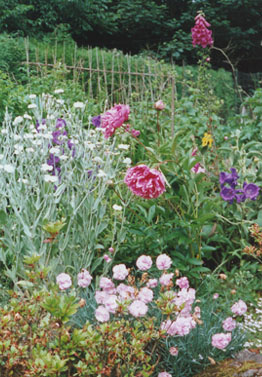 The foxgloves, which have given another excellent display this season, are all but finished. On the 3rd I picked the first bunch of sweet peas.
The foxgloves, which have given another excellent display this season, are all but finished. On the 3rd I picked the first bunch of sweet peas. 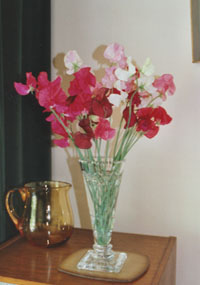 In the house they soon filled the room with their sweet scent; we look forward to picking many more throughout the season. For a few weeks on several evenings near dusk the blackbirds have been making a great commotion. It has ended by a tawny owl being chased from tree to tree around the garden. For several nights there has been a lot of hooting after dark. In the greenhouse on the 6th we have picked the first cucumber of the season. They have a marvellous flavour when fresh and slightly warm from the greenhouse. We try to have them the same time as tomatoes, but this year the cucumbers are ready but not the tomatoes. There are plenty of green tomatoes but they are not ripening. They we planted a little late and the weather has been both dull and cold. The small-fruited Gardeners Delight is fine, but tomatoes on several plants of the larger Cumulus and the very large continental type Super Marmande plants have blossom end rot. I have seen this occasionally in previous years on the continental type but not as extensive as this year. It is a physiological disorder associated with the conditions under which the plants are growing. Possible causes include water balance, temperature and calcium deficiency. It tends to be more prevalent in tomatoes grown in bags although it occurs also in soil grown plants. We did have a very hot day on the 18th June when the temperature reached 29.0C and the humidity dipped to 46%. The next day I noticed a little leaf scorch on the topmost leaves near the glass. A dry atmosphere in a greenhouse at night can also cause the problem. The odd thing about it is that the Gardeners Delight are unaffected as are individual plants of the other varieties. There is no pattern to the distribution of affected plants and in some bags one plant is affected while the other is not. What ever caused it the result is that the crop, which was looking very good, will be considerably reduced.
In the house they soon filled the room with their sweet scent; we look forward to picking many more throughout the season. For a few weeks on several evenings near dusk the blackbirds have been making a great commotion. It has ended by a tawny owl being chased from tree to tree around the garden. For several nights there has been a lot of hooting after dark. In the greenhouse on the 6th we have picked the first cucumber of the season. They have a marvellous flavour when fresh and slightly warm from the greenhouse. We try to have them the same time as tomatoes, but this year the cucumbers are ready but not the tomatoes. There are plenty of green tomatoes but they are not ripening. They we planted a little late and the weather has been both dull and cold. The small-fruited Gardeners Delight is fine, but tomatoes on several plants of the larger Cumulus and the very large continental type Super Marmande plants have blossom end rot. I have seen this occasionally in previous years on the continental type but not as extensive as this year. It is a physiological disorder associated with the conditions under which the plants are growing. Possible causes include water balance, temperature and calcium deficiency. It tends to be more prevalent in tomatoes grown in bags although it occurs also in soil grown plants. We did have a very hot day on the 18th June when the temperature reached 29.0C and the humidity dipped to 46%. The next day I noticed a little leaf scorch on the topmost leaves near the glass. A dry atmosphere in a greenhouse at night can also cause the problem. The odd thing about it is that the Gardeners Delight are unaffected as are individual plants of the other varieties. There is no pattern to the distribution of affected plants and in some bags one plant is affected while the other is not. What ever caused it the result is that the crop, which was looking very good, will be considerably reduced.  On the vegetable plot I worked-in a liberal quantity of Marshalls' Organic Extra (with added seaweed) manure on the last as yet unplanted area. We have been using this manure for several years; it is good for everything in the garden from potatoes to roses. It has the advantage of being concentrated, but light in weight. Two 2 rows of the leek Giant Winter were then planted. These were raised in the greenhouse in a seed tray and are already about 10-12 cm tall. I pick out the best plants, trim the roots back to 1-2 cm long and drop them into a hole (about 3cm wide by 6 cm deep) made in the soil with the broken handle of a small spade. After planting a liberal watering washes soil into the hole, nothing else need be done but watch them grow. Also planted out were 2 rows of purple sprouting broccoli, raised in modules. There was just room for 2 rows of lettuce, but this time the seed will be sown directly into the soil. Germination of lettuce seed is more difficult at the higher temperatures in the greenhouse during the summer. I sowed a row of Little Gem and a mixed row of Salad Bowl varieties. The vegetable plot is now fully planted. Not a square inch to spare. Since giving up one of the plots it has been a job to fit everything in, and one or two crops have had to be left out. Things we used to grow included rows of onions, beetroots and parsnips.
On the vegetable plot I worked-in a liberal quantity of Marshalls' Organic Extra (with added seaweed) manure on the last as yet unplanted area. We have been using this manure for several years; it is good for everything in the garden from potatoes to roses. It has the advantage of being concentrated, but light in weight. Two 2 rows of the leek Giant Winter were then planted. These were raised in the greenhouse in a seed tray and are already about 10-12 cm tall. I pick out the best plants, trim the roots back to 1-2 cm long and drop them into a hole (about 3cm wide by 6 cm deep) made in the soil with the broken handle of a small spade. After planting a liberal watering washes soil into the hole, nothing else need be done but watch them grow. Also planted out were 2 rows of purple sprouting broccoli, raised in modules. There was just room for 2 rows of lettuce, but this time the seed will be sown directly into the soil. Germination of lettuce seed is more difficult at the higher temperatures in the greenhouse during the summer. I sowed a row of Little Gem and a mixed row of Salad Bowl varieties. The vegetable plot is now fully planted. Not a square inch to spare. Since giving up one of the plots it has been a job to fit everything in, and one or two crops have had to be left out. Things we used to grow included rows of onions, beetroots and parsnips.
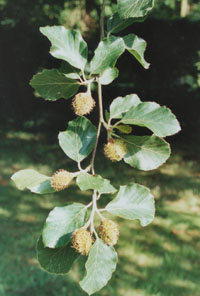 On the 8th we were able to see the owl perched in the large beech tree. We assume it stays around in the trees during the day and gets active during the night. We see it starting to fly about at dusk and have heard a lot of hooting during the night. There are periods when we see a lot of the owls then some weeks go by before they are seen or heard again. This seems to be related to their choice of hunting ground. They work around their home base concentrating on one location before moving on to another. In due course they will return, no doubt in expectation that the small mammal population will have built up again.
On the 8th we were able to see the owl perched in the large beech tree. We assume it stays around in the trees during the day and gets active during the night. We see it starting to fly about at dusk and have heard a lot of hooting during the night. There are periods when we see a lot of the owls then some weeks go by before they are seen or heard again. This seems to be related to their choice of hunting ground. They work around their home base concentrating on one location before moving on to another. In due course they will return, no doubt in expectation that the small mammal population will have built up again. 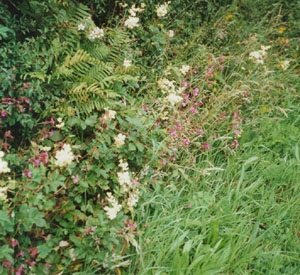 A walk around the lanes on the 9th showed that some of the autumn sown barley is nearly ripe. At the bottom of one field in an area that was very wet overwinter what barley survived is both greener and taller. The wild roses have more or less finished; disappointingly they have not been very prolific this year. In places the honeysuckle has been doing better, being covered in flowers and giving on still sunny days plenty of perfume. On the banks of hedges and walls the grasses have well developed flower heads and merge in with red campion Melandrium rubrum, meadow-sweet Filipendula ulmaria and several ferns. The blackberries are beginning to flower, most are white flowers there are some pink as well. One pasture field had about 150 rooks in it gleaning food. Along the hedgerows I saw several wrens and a flock of 20, or so, sparrows near a chicken farm. Sparrows are getting fewer in number so it is good to see that this group is doing well. Wet and windy weather overnight on the 9/10th, the most rain for a month waters the garden and again the wind gusting to force 7 does minor damage to the flowering plants. More leaves and twigs are removed from the trees in the strong wind. Some of beech twigs have well formed beechnuts and many of the small horse chestnuts have been blown away. The horse chestnut trees bloomed so well this year that a bumper crop of conkers had been expected. Recent cold weather has turned the leaves of the runner bean plants quite yellow. Despite this there are one or two pink flowers are appearing. There is also some bud drop on the sweet peas, but there are a lot of flowers coming. We cut every 3-4 days; each time the bunches get larger and are enough now to fill 2 vases. Buccaneer (deep crimson) is doing really well as are Dean's Scarlet, Royal Wedding (White) and one of our favourites Beaujolais.
A walk around the lanes on the 9th showed that some of the autumn sown barley is nearly ripe. At the bottom of one field in an area that was very wet overwinter what barley survived is both greener and taller. The wild roses have more or less finished; disappointingly they have not been very prolific this year. In places the honeysuckle has been doing better, being covered in flowers and giving on still sunny days plenty of perfume. On the banks of hedges and walls the grasses have well developed flower heads and merge in with red campion Melandrium rubrum, meadow-sweet Filipendula ulmaria and several ferns. The blackberries are beginning to flower, most are white flowers there are some pink as well. One pasture field had about 150 rooks in it gleaning food. Along the hedgerows I saw several wrens and a flock of 20, or so, sparrows near a chicken farm. Sparrows are getting fewer in number so it is good to see that this group is doing well. Wet and windy weather overnight on the 9/10th, the most rain for a month waters the garden and again the wind gusting to force 7 does minor damage to the flowering plants. More leaves and twigs are removed from the trees in the strong wind. Some of beech twigs have well formed beechnuts and many of the small horse chestnuts have been blown away. The horse chestnut trees bloomed so well this year that a bumper crop of conkers had been expected. Recent cold weather has turned the leaves of the runner bean plants quite yellow. Despite this there are one or two pink flowers are appearing. There is also some bud drop on the sweet peas, but there are a lot of flowers coming. We cut every 3-4 days; each time the bunches get larger and are enough now to fill 2 vases. Buccaneer (deep crimson) is doing really well as are Dean's Scarlet, Royal Wedding (White) and one of our favourites Beaujolais.
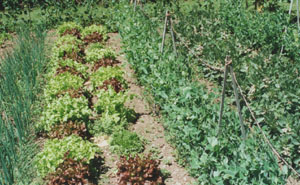 On the vegetable plot on the 14th there are good flowers on the rows of peas and dwarf broad beans. The broad beans need the services of the bumblebees to pollinate them; I hope they not spend all their time on the flower borders. The lettuce seed sowed on the 7th have germinated. When they have grown a little more they will need to be thinned out. Of the early lettuce the Little Gem have nearly finished but there are plenty of salad bowl. These are now quite large plants and can be cut whole if required. We leave the base in the ground and this will often shoot again producing a sort of coppiced lettuce. The female pheasant turned up again today with 2 small chicks. In another attempt to raise a family. She ate some seed from a feeding tray near the wood before passing on her way. We have not seen her, or the chicks, since. Later there was a buzzard around the wood.
On the vegetable plot on the 14th there are good flowers on the rows of peas and dwarf broad beans. The broad beans need the services of the bumblebees to pollinate them; I hope they not spend all their time on the flower borders. The lettuce seed sowed on the 7th have germinated. When they have grown a little more they will need to be thinned out. Of the early lettuce the Little Gem have nearly finished but there are plenty of salad bowl. These are now quite large plants and can be cut whole if required. We leave the base in the ground and this will often shoot again producing a sort of coppiced lettuce. The female pheasant turned up again today with 2 small chicks. In another attempt to raise a family. She ate some seed from a feeding tray near the wood before passing on her way. We have not seen her, or the chicks, since. Later there was a buzzard around the wood. 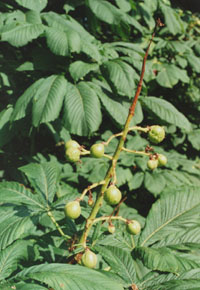 We have not seen the male pheasant around either, but as this is the time when they moult he may be hiding away somewhere. There are very few wild pheasants around now. When we first came to live here (30 years ago) it was quite common to see several birds in the field across the road from the house. Since then the numbers seen have declined and the wet summers of the previous 3 years probably have not helped. There have not been many butterflies around so far this year. Earlier in the year we saw one or two peacock butterflies and an orange tip. Recently Patricia saw a single sighting of a small blue but apart from the odd cabbage white, nothing else. We usually see a red admiral or two, several more peacocks and small tortoiseshells by this time in the summer. Our buddleias have yet to flower and these usually are a great attraction.
We have not seen the male pheasant around either, but as this is the time when they moult he may be hiding away somewhere. There are very few wild pheasants around now. When we first came to live here (30 years ago) it was quite common to see several birds in the field across the road from the house. Since then the numbers seen have declined and the wet summers of the previous 3 years probably have not helped. There have not been many butterflies around so far this year. Earlier in the year we saw one or two peacock butterflies and an orange tip. Recently Patricia saw a single sighting of a small blue but apart from the odd cabbage white, nothing else. We usually see a red admiral or two, several more peacocks and small tortoiseshells by this time in the summer. Our buddleias have yet to flower and these usually are a great attraction. 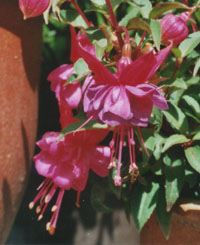 speckled woods but these too are absent so far. One year we were lucky enough to see as many as 20 painted lady butterflies, but this was a rare event which has not yet been repeated. On recent visits to Malltraeth we have seen a lot of butterflies over ungrazed meadow-type vegetation. Apart from our garden and the woodland the surrounding fields are deserts in comparison. If only the fields could have a boundary edge of 1 or 2 metres, both sides of the hedge or wall left uncultivated for natural vegetation to grow. This would make such a big difference providing habitat for plants, insects, butterflies and small mammals. The weather has turned a little warmer and on the 20th the runner bean leaves were looking much greener. Some plants have reached the top of the 8ft canes and there are plenty of pink flowers awaiting pollination. There are small peas formed on the Onward and Sugar Snap peas. The soil is now looking very dry and it has been necessary to water the seedling lettuce, leeks and broccoli plants. Now that the peas are forming I will also water these, until now it was unnecessary. The courgette plants are producing plenty of female flowers, but male flowers are in short supply. This usually happens at the start of the season; we try to fertilise some of the female flowers to ensure an early crop. Later on the insects will do the job for us very well indeed. The potatoes are also looking promising. There have been flowers on the early French variety for a while so they soon could be ready for digging; the Pink Fir Apple is now also flowering. We have been picking a few raspberries but the blackbirds seem to have been having most. They are the last of a variety called Leo, which we have grown for several years. It is a tall variety of excellent flavour and good for freezing. Its vigour has unfortunately declined and in the last 2 years many canes have been dying. So the canes will have to be replaced. It was planned to dig them up last autumn but it was a job that did not get done. This spring some canes looked promising and they were reprieved. But they will have to go as soon as the berries have finished.
speckled woods but these too are absent so far. One year we were lucky enough to see as many as 20 painted lady butterflies, but this was a rare event which has not yet been repeated. On recent visits to Malltraeth we have seen a lot of butterflies over ungrazed meadow-type vegetation. Apart from our garden and the woodland the surrounding fields are deserts in comparison. If only the fields could have a boundary edge of 1 or 2 metres, both sides of the hedge or wall left uncultivated for natural vegetation to grow. This would make such a big difference providing habitat for plants, insects, butterflies and small mammals. The weather has turned a little warmer and on the 20th the runner bean leaves were looking much greener. Some plants have reached the top of the 8ft canes and there are plenty of pink flowers awaiting pollination. There are small peas formed on the Onward and Sugar Snap peas. The soil is now looking very dry and it has been necessary to water the seedling lettuce, leeks and broccoli plants. Now that the peas are forming I will also water these, until now it was unnecessary. The courgette plants are producing plenty of female flowers, but male flowers are in short supply. This usually happens at the start of the season; we try to fertilise some of the female flowers to ensure an early crop. Later on the insects will do the job for us very well indeed. The potatoes are also looking promising. There have been flowers on the early French variety for a while so they soon could be ready for digging; the Pink Fir Apple is now also flowering. We have been picking a few raspberries but the blackbirds seem to have been having most. They are the last of a variety called Leo, which we have grown for several years. It is a tall variety of excellent flavour and good for freezing. Its vigour has unfortunately declined and in the last 2 years many canes have been dying. So the canes will have to be replaced. It was planned to dig them up last autumn but it was a job that did not get done. This spring some canes looked promising and they were reprieved. But they will have to go as soon as the berries have finished. 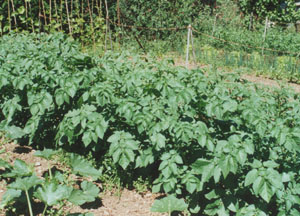 When we had 2 complete rows there was plenty for the blackbirds and us. Now they are fewer the blackbirds win most of what is there. Varieties come and go and we cannot see Leo in the catalogues anymore, but there are some good new virus free varieties available. We hope we can pick one that has as good a flavour. As we have not got spare ground to replant the row will be left fallow for 18 months to hopefully rid the soil of any raspberry diseases. We used to grow strawberries quite successfully until the grey squirrels arrived. We tried netting the plot but they always were able to get in and would sit on a flowerpot eating the strawberries! Then a fruit farm started just along the road from here so we go there to pick our strawberries and gooseberries. On the 22nd the orange day-lily Hemerocallis is just starting as are a bronze fennel and the thistle-like Echinops ritro. On the top of the rockery terraces, just below the herbaceous border, are the white bell-like Daboieca vegans and a peach coloured Potentilla. On the terrace are the 3 pots of the pink geranium (Pelargonium) that has been in flower since January. These were kept outside in the shelter of a corner of the house and moved out to their present sunny position in May. The flowers are now perfectly pink, in colder weather they have blotches of white on the pink.
When we had 2 complete rows there was plenty for the blackbirds and us. Now they are fewer the blackbirds win most of what is there. Varieties come and go and we cannot see Leo in the catalogues anymore, but there are some good new virus free varieties available. We hope we can pick one that has as good a flavour. As we have not got spare ground to replant the row will be left fallow for 18 months to hopefully rid the soil of any raspberry diseases. We used to grow strawberries quite successfully until the grey squirrels arrived. We tried netting the plot but they always were able to get in and would sit on a flowerpot eating the strawberries! Then a fruit farm started just along the road from here so we go there to pick our strawberries and gooseberries. On the 22nd the orange day-lily Hemerocallis is just starting as are a bronze fennel and the thistle-like Echinops ritro. On the top of the rockery terraces, just below the herbaceous border, are the white bell-like Daboieca vegans and a peach coloured Potentilla. On the terrace are the 3 pots of the pink geranium (Pelargonium) that has been in flower since January. These were kept outside in the shelter of a corner of the house and moved out to their present sunny position in May. The flowers are now perfectly pink, in colder weather they have blotches of white on the pink. 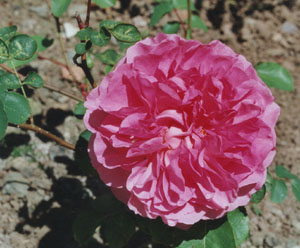 Other pots containing the fuchsias Annabel, Winston Churchill and Royal Velvet are now well into flowering. There are also pots of multicoloured Nemesia and trailing Lobelia that were raised from seed in the greenhouse earlier in the year. On the steps leading up from the terrace to the Weather Station is a pot of mauve Mesembryanthemum. Today, in the warm sunshine, all its many flowers are wide open but as soon as the sun moves behind the trees they will close. Unlike the Cistus it will not drop its petals and will open again tomorrow as long as it is warm and sunny. As the plant is half-hardy we find it best to grow in a large pot and move it into the greenhouse for the winter. It will grow in some sheltered gardens in the area but not in this one. We picked the first ripe tomatoes on the 26th, just a few Gardeners Delight and one experimental plum-shaped sort. The flavour was delicious and far better than anything that can be bought in a supermarket. Within the last few days many have began to turn colour so it should not be long before we have a good supply. Though still small bushes the recently planted roses, on the newly developed border, have been flowering continuously for some weeks. One, a semi-double English Rose The Herbalist has had some fine blooms this month. This David Austin bred rose is named out of its similarity to Officinalis (the Apothecary's Rose).
Other pots containing the fuchsias Annabel, Winston Churchill and Royal Velvet are now well into flowering. There are also pots of multicoloured Nemesia and trailing Lobelia that were raised from seed in the greenhouse earlier in the year. On the steps leading up from the terrace to the Weather Station is a pot of mauve Mesembryanthemum. Today, in the warm sunshine, all its many flowers are wide open but as soon as the sun moves behind the trees they will close. Unlike the Cistus it will not drop its petals and will open again tomorrow as long as it is warm and sunny. As the plant is half-hardy we find it best to grow in a large pot and move it into the greenhouse for the winter. It will grow in some sheltered gardens in the area but not in this one. We picked the first ripe tomatoes on the 26th, just a few Gardeners Delight and one experimental plum-shaped sort. The flavour was delicious and far better than anything that can be bought in a supermarket. Within the last few days many have began to turn colour so it should not be long before we have a good supply. Though still small bushes the recently planted roses, on the newly developed border, have been flowering continuously for some weeks. One, a semi-double English Rose The Herbalist has had some fine blooms this month. This David Austin bred rose is named out of its similarity to Officinalis (the Apothecary's Rose).
Document dated: 29 July 2000. This page is part of the site maintained at http://www.llansadwrn-wx.co.uk
Copyright ©: 2000 Donald and Patricia Perkins